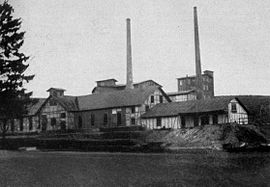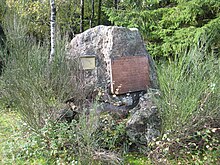Landeskrone mine
| National crown | |||
|---|---|---|---|
| General information about the mine | |||
| Mine around 1880 | |||
| Rare minerals | Cerussite , millerite , ullmannite , pyromorphite , tetrahedrite | ||
| Information about the mining company | |||
| Employees | 200 (1852) | ||
| Start of operation | February 26, 1298 | ||
| End of operation | 1901 | ||
| Funded raw materials | |||
| Degradation of | Lead ore , silver ore | ||
| Greatest depth | 94 m | ||
| Geographical location | |||
| Coordinates | 50 ° 48 '5 " N , 8 ° 5' 40" E | ||
|
|||
| Location | Savages | ||
| local community | Wilnsdorf | ||
| District ( NUTS3 ) | Siegen-Wittgenstein | ||
| country | State of North Rhine-Westphalia | ||
| Country | Germany | ||
| District | Bergrevier Siegen II | ||
The pit Landeskrone was a lead and silver mine in the district of savages , in the municipality Wilnsdorf in Siegen-Wittgenstein ( Nordrhein-Westfalen ). Because the ore came to the surface in the Wildens district after the deep adit was built at the beginning of the 19th century, it was a “wild mine”. Due to the location of the corridor in the Wilnsdorf district, however, it was administered by the Siegen II mining district . Among other things, royal silver was made from the lead ore extracted from the mine .
Aisle means
The middle of the corridor was the Göpelschacht corridor with a length of 35 m and a thickness of 0.94 to 1.25 m. It was filled with lead and pale ores . The Liebfrauengang was divided into six individual remedies; here, too, predominantly lead ore was used, but from the third level the spate iron stone increased. The individual means were:
- Western mean; 25 m long, 0.94–1.25 m thick
- 1. Southern mean; 44 m long, 0.5–1.5 m thick
- 2. Southern mean; 38.6 m long, up to 6 m thick
- 3. Southern mean; 77 m long, 0.94–2 m thick
- 4. Southern mean; 29 m long, 0.94–1.25 m thick
- Northern Middle; 29 m long, 0.3–1 m thick
The lead content in the ore was 60–70%; 100 kg of lead ores yielded 30-40 g of silver.
history
One can only guess how far back the history of the mine goes. The pit was first mentioned on February 26, 1298; King Adolf von Nassau pledged his cousins, Count Heinrich and Emich von Nassau and their brothers, the area "with the mine at Ratzenscheit and with all mines in their countries where silver can be sought and found" for 1000 marks Cologne pfennigs . This makes the Ratzenscheid mine the oldest documented mention of the Siegerland . This pledge established the Bergregal of the Counts of Nassau. The cutting of the 500 m long upper gallery goes back to the 13th century. Most of it was only 15 cm wide and 80 cm high and was filled in during the construction of the Federal Motorway 45 in the 1960s.
On July 14th, 1489 the mine “to our dear women”, the Liebfrauengang of the state crown, was divided into 32 kuxe. The mine had several, more or less short operating periods in the following centuries: 1684–1740; 1780-1790; from 1801; 1810-1814; from 1821; from 1835. On September 28, 1793, the pit was muted as Gleiskude anew. The Göpelschacht was built from 1798 to a depth of 95 m and abandoned again in 1809. In 1810 it could only be driven down to a depth of 65 m. On April 10, 1980, it was backfilled after a collapse.
The last name of the mine, Landeskrone , dates back to 1801. On the Landeskrone in the Wildebachtal , the construction of a deep tunnel began in February 1801 , which later served as the pit's hereditary tunnel . A notice board inside the tunnel with the year as an inscription testifies to its completion in 1839. The tunnel is at a height of almost 348 m above sea level. NN .
|
||||||||||||||||||||||||||||||||||||||||
In 1852 one of the first steam engines in Siegerland was put into operation on the mine and an underground machine house was built for it. The sunk shaft reached 120 m in 1862, 150 m in 1863 and in 1864 a depth of approx. 200 m below the surface. The depth under the bottom of the tunnel was 94 m. Levels were created at 31, 62 and 94 m. The steam engine was located at a depth of approx. 80 m underground on the bottom of the tunnel, had 10 HP and reached speeds of 1 m per second. Two boilers supplied the machine with air. The piston of the machine was 11 "(about 27.94 cm) in diameter. It made 48 strokes per minute with a stroke length of 30" (about 76.2 cm). The acquisition cost of the machine in 1852 was 11,000 thalers (approx. 33,000 marks). Between 1800 and 1880 5014 t of galena, 12 t of copper ore, 487 t of zinc blende, 37 t of pale ore and 633 t of siderite ore were mined. Then the funding was stopped.
The Landeskroner Weiher , through which the Wildebach flows, was created in 1890 to operate the treatment more effectively and is now a popular swimming destination on hot summer days. By 1900 zinc production was twice as high as lead production. On December 28, 1900, the consolidation with the New Hope mine in Wilgersdorf took place . As early as 1901, funding from the Landeskroner side was stopped. The mine had up to 200 workers, in 1862 there were 120, in 1866 78 and in 1867 only 62. In 1897 there were only 20 miners. In 1913 the production was also stopped by the New Hope mine . After the mine was closed, the old portal of the deep gallery was demolished in 1922. In 1949 the current portal was built and the tunnel was used to supply the community of Wilden with water. In 1958/59, Erzbergbau Siegerland AG carried out investigations in the mine area. Four core drillings were carried out, one of which examined the development of the Liebfrauen Ganges on the 720 m level of Bautenberg. However, the examinations were negative and renewed funding was no longer started.
As part of the planned expansion of Autobahn 45 , the deep Landeskroner tunnel was opened in 2016 in order to be able to test the stability of the cavities under the Autobahn. The shaft hall, built from 1852 and built with sandstones and bricks, was rediscovered. This is located about 800 m from the tunnel mouth hole in the mountain and was thoroughly documented after its rediscovery by a research team from the Landschaftsverband Westfalen-Lippe (LWL) , the German Mining Museum Bochum and the Association for Siegerland Mining. A 3D model of the shaft hall was calculated using countless photographs.
In April 2018, interested parties had the first opportunity to see the inside of the shaft hall after registering and as part of a regional specialist conference on the Landeskrone pit.
Consolidations
In addition to New Hope , there was further consolidation. The Sophie mine , which was already in operation in the 16th century, was located on the Bautenberg ; iron and lead ore were mined in several upper tunnels and a small shaft.
Further consolidations:
- Dusk , Wilnsdorf
- Abendstern , Wilnsdorf
- Fresh field , savages
- Morgenröthe , Wilnsdorf / Wilden
- Oil leaf , Wilnsdorf
See also
literature
- JD Engels: The state crown at the Ratzenscheid , Herborn 1803
- Article Wilnsdorfer Silber for the King - Ancient mine “Ratzenscheid” was later called “Landeskrone” / exhibition on Sunday in the Siegener Zeitung of February 25, 2010, page 10
Individual evidence
- ^ Journal for the mining, smelting and salt works in the Prussian state , Berlin; Issues 1854–1869
- ^ Franz Dango: Wilnsdorf - history and landscape , Vorländer publishing house, Siegen 1955; P. 307
- ^ Gerhard Schäfer: The valley railway in the free reason. In: Regional traffic history. Volume 24. EK-Verlag, Freiburg 1998, ISBN 3-88255-438-X
- ^ Westfalenpost: Underground: Hunters of the lost steam engine from Wilnsdorf , accessed on March 5, 2019.
- ↑ LWL.org: An important underground industrial monument documented for the first time , accessed on March 5, 2019.
- ↑ Association for Siegerland Mining: Grube Landeskrone , accessed on March 5, 2019.
- ↑ siegerlandkurier.de: Regional Conference to the pit Landeskrone in Wilnsdorfer Museum , accessed on 5 March of 2019.
Web links
- 3D-model of the shaft hall of the Landeskrone mine
- Gerd Bäumer: Ore mining in the Siegerland area ( Memento from November 7, 2001 in the Internet Archive )
- Description of the Landeskroner steam engine (PDF, 175 kB)
- Regest text of February 26, 1298







